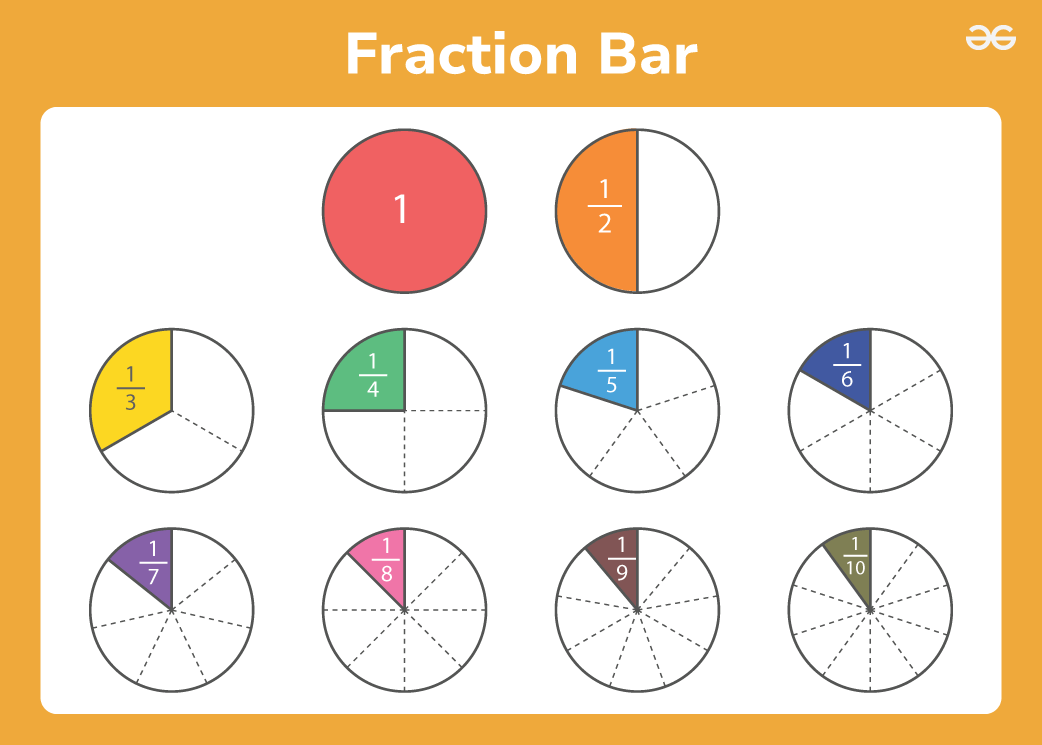
|
|
Fraction bars are visual and hands-on tools used to teach and understand fractions. They provide a simple way to see the size of different fractions and how they relate to each other. These are especially helpful in elementary and middle school education for introducing and reinforcing concepts of fractions.  In this article, we will understand fraction bars and solve some questions with fraction bars. Table of Content What are Fraction Bars?In mathematics, a fraction bar is a visual tool that helps compare fractions and perform fraction operations. Fraction bars or strips represent a part-to-whole relationship. Each segment of a fraction bar represents one part of the whole. This is why it is called a part-to-whole representation. A fraction bar is divided into equal parts, and the number of shaded parts shows the fraction being represented. Definition of Fraction Bars
Fraction strips are rectangular pieces of paper that are divided into equal parts to represent different fractions. Each strip is usually marked with fractional values such as 1/2, 1/3, 1/4, and so on. They are often color-coded to make it easier to differentiate between various fractions. Comparing Fractions using Fraction BarsFraction strips or fraction bars are a visual and interactive tool that help students understand and compare the sizes of different fractions. They are helpful in comparing fractions in an easy way. Here are few examples for the same: Example: Comparing 1/2 and 2/3Solution: 
Example: Comparing 3/4 and 5/6Solution: 
Algebraic Expressions with Fraction BarsWhen solving an algebraic expressions that include fraction bars, it is important to consider these bars as grouping symbols, similar to parentheses. Some key points to use while solving algebraic expressions with fraction bars are: Invisible ParenthesesBoth the numerator and the denominator of a fraction can be considered to have invisible parentheses around them. Suppose, in an algebraic expression [Tex]\frac{3 + 3}{4 \times 1}[/Tex] there is no visible parentheses. Hence, while solving the fraction, first all operations of the numerator and the denominator should be solved separately. Like in the fraction given above,
Now, as the invisible parentheses of numberator and denominator are solved, we can solve the new fraction as a whole, 6/4 = 3/2 Order of Operations- PEMDASPEMDAS expands to parentheses, exponents, multiplication, division, addition and subtraction. Order of operations means, solving the algebraic expression using PEMDAS rule starting with operation P for parentheses then E, M, D, A, and S. Suppose in an algebraic equation 3+4×2-5, we have to use PEMDAS rule.
This is how PEMDAS is used to solve an algebraic expressions.
Parentheses in Numerator or DenominatorIf there are actual parentheses within the numerator or denominator, those operations take precedence over the fraction bar. Solve everything inside these parentheses before addressing the fraction. Parentheses Outside the FractionIf there are parentheses outside of the fraction, the fraction bar itself takes precedence over the operations inside these outer parentheses. Example of Algebraic Expressions with Fraction BarsExample: Given: [Tex]\frac{(3 + 2) \times 4}{(1 + 1) \times 2}[/Tex] Solution:
Benefits of Using Fraction Bars
Read More: Solved Examples on Fraction BarsExample 1: Simplify the expression [Tex]\frac{5 \times (2 + 3)}{4 – 1}[/Tex].Solution:
Example 2: Comparing 7/10 and 4/5Solution:
Example 3: If a fraction bar is divided into 6 equal parts and 3 parts are shaded, what fraction of the bar is shaded?Solution:
Example 4: A rectangle is divided into 8 equal parts by a fraction bar. If 5 of these parts are shaded, what fraction of the rectangle is shaded?Solution:
Fraction Bars Worksheet: UnsolvedFAQs on Fraction BarsWhat are fraction bars?
What are Fraction strips?
What are fraction bars called?
What is 0.5 bar fraction?
Why are fraction bars important?
What is an example of a fraction bar?
Who was the first to use a fraction bar?
What is the difference between a fraction bar and a number line?
|
Reffered: https://www.geeksforgeeks.org
| Mathematics |
| Related |
|---|
| |
| |
| |
| |
| |
Type: | Geek |
Category: | Coding |
Sub Category: | Tutorial |
Uploaded by: | Admin |
Views: | 17 |